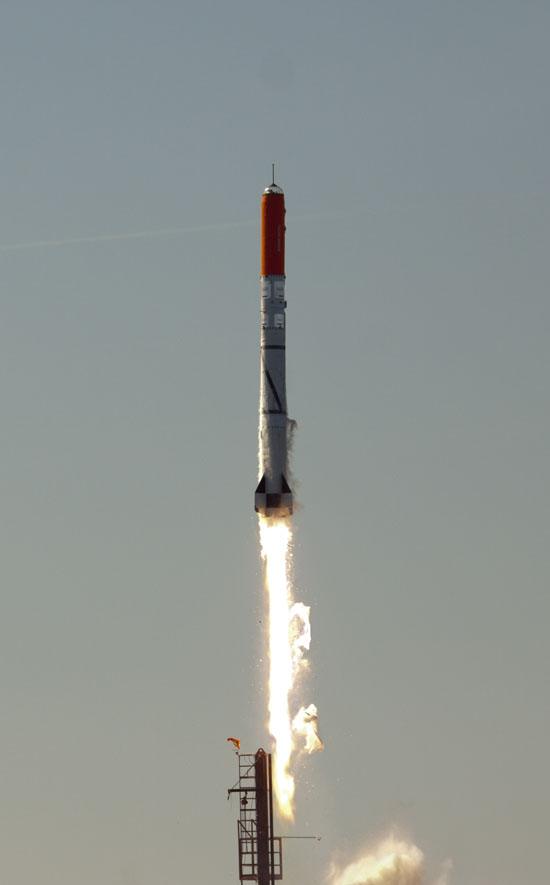
A private Danish rocket launched into the sky today (June 3) on its first successful test flight — a trip that didn't reach anywhere near space but did mark a huge step forward for the team's plan to eventually loft people on cheap suborbital spaceflights.
The Danish non-profit outfit Copenhagen Suborbitals launched its homemade rocket, called HEAT-1X, at about 10:30 a.m. EDT (1430 GMT) from a floating platform in the Baltic Sea.
"We did it …" the group announced on its website after the successful flight.
A photo released by the project team shows the HEAT-1X rocket soaring skyward atop a pillar of flame with a see-through nosecone, where a dummy passenger sat. [See a photo of the Danish rocket launch]
The booster, which was carrying a space capsule dubbed Tycho Brahe, reached an altitude of about 2 miles (3.2 kilometers) before its parachute deployed and it fell back into the sea, Fox News reported.
Two miles might not sound like much, and the team had earlier expressed hopes that the flight would soar as high as 10 miles (16 km) high or so. The boundary of space is widely considered to be at an altitude of about 62 miles (100 km).
But the amateur rocketeers are counting today's test as an unqualified success, and a big step forward in their quest to launch tourists on suborbital flights someday. That success is especially sweet since it comes after a 2010 launch try that was thwarted by a system malfunction.
Get the Space.com Newsletter
Breaking space news, the latest updates on rocket launches, skywatching events and more!
"The feeling is incredible, and we will take everything we have learned home with us," Copenhagen Suborbitals co-founder Peter Madsen said after the test, according to Danish newspaper The Copenhagen Post. "We are a lot wiser now about how to get a rocket into the air."
Madsen's partner, fellow Copenhagen Suborbitals co-founder Kristian von Bengtson, echoed those sentiments.
"It’s a success that we have gotten the rocket up into the air, and I think that we have written a little bit of history," von Bengtson said, according to The Copenhagen Post. [Vote Now! The Best Spaceships of All Time]
Human spaceflight, on the cheap
The goal of Copenhagen Suborbitals, which has been running full-steam since 2008, is to launch people into suborbital space — and to do it on the extreme cheap.
They'll use the Tycho Brahe capsule to carry folks. It's a snug spacecraft, allowing room for one astronaut to half-sit and half-stand. It weighs about 660 pounds (nearly 300 kg) — including the weight of its passenger — and is about 11.5 feet (3.5 meters) long, according to the Copenhagen Suborbitals description.
"We aim to show the world that human space flight can be different from the usual expensive and government controlled project," the Copenhagen Suborbitals website states. "We are working fulltime to develop a series of suborbital space vehicles — designed to pave the way for manned space flight on a micro size spacecraft."
Madsen and von Bengston rely on private donations and money from sponsors to fund this ambitious endeavor. So far, they've been extremely efficient; the pair claims to have spent just $60,000 per year developing the HEAT-1X and Tycho Brahe, according to Fox News.
Second time's the charm
Copenhagen Suborbitals wanted to test-fly the HEAT-1X and Tycho Brahe back in September 2010. They were all ready to go, even towing the launch platform out to its blastoff site in the Baltic Sea.
However, that launch attempt had to be scrubbed when a liquid oxygen valve in the rocket became stuck. Madsen and von Bengston later determined that the problem lay with a standard hair dryer, which they had incorporated into the design as a heater.
But after several more months back at the drawing board, the Danes fixed the problem and sent their homemade spaceflight system soaring skyward.
Today's test flight helps validate much of the team's work up to this point, giving them confidence as they move forward in the development of a reliable, affordable spaceflight system.
You can follow SPACE.com senior writer Mike Wall on Twitter: @michaeldwall. Follow SPACE.com for the latest in space science and exploration news on Twitter @Spacedotcom and on Facebook.
Join our Space Forums to keep talking space on the latest missions, night sky and more! And if you have a news tip, correction or comment, let us know at: community@space.com.

Michael Wall is a Senior Space Writer with Space.com and joined the team in 2010. He primarily covers exoplanets, spaceflight and military space, but has been known to dabble in the space art beat. His book about the search for alien life, "Out There," was published on Nov. 13, 2018. Before becoming a science writer, Michael worked as a herpetologist and wildlife biologist. He has a Ph.D. in evolutionary biology from the University of Sydney, Australia, a bachelor's degree from the University of Arizona, and a graduate certificate in science writing from the University of California, Santa Cruz. To find out what his latest project is, you can follow Michael on Twitter.









